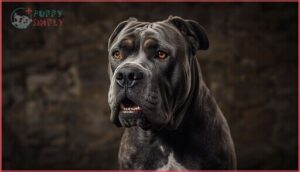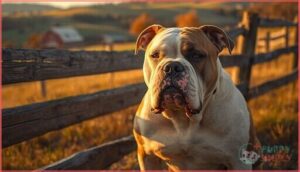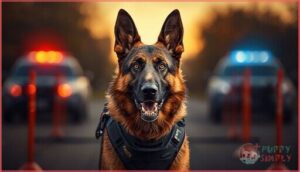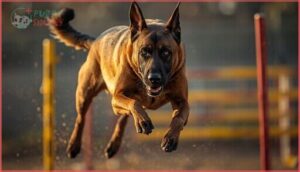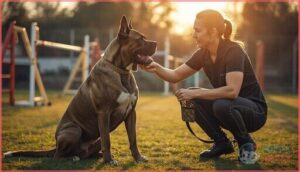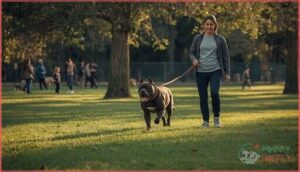This site is supported by our readers. We may earn a commission, at no cost to you, if you purchase through links.
Your neighbor’s Kangal just sank its teeth into a thick branch during yesterday’s walk—the wood splintered like kindling. That display of raw power wasn’t a fluke. Breeds developed for livestock protection and big-game hunting can generate jaw pressure exceeding 700 PSI, roughly three times what the average person produces with their hands.
Understanding which dog breeds with the strongest bite top the charts isn’t about fear-mongering; it’s about respecting the engineering marvel these animals represent and recognizing what responsible ownership demands. Skull architecture, muscle composition, and centuries of selective breeding have created canines capable of extraordinary bite force—but those same genetics require informed handling, early socialization, and realistic expectations about training needs.
Table Of Contents
Key Takeaways
- Bite force measurements range from 195 PSI (Belgian Malinois) to 743 PSI (Kangal), but these numbers reflect skull structure and muscle composition more than danger—temperament, training, and socialization determine real-world risk far more than raw jaw strength.
- Early socialization before 16 weeks cuts fear-related behaviors by 40% and reduces severe bite risk by up to 60%, making those first few months your most critical window for shaping a powerful breed’s behavior throughout its life.
- Breeds with the strongest bites were developed for specific working roles—livestock protection, big-game hunting, or guarding—so their jaw power isn’t random aggression but rather centuries of selective breeding that demands experienced handling and realistic expectations.
- Responsible ownership of high bite-force breeds requires daily structured exercise (60+ minutes), consistent positive reinforcement training, proper containment that reduces stray interactions by 60%, and the ability to recognize pre-bite warning signals that appear in 60% of incidents but often go ignored.
What Determines a Dog’s Bite Force?
You might think a dog’s bite force is just about size, but it’s more complex than that. Scientists measure bite strength using specialized sensors, but the numbers you see aren’t always straightforward.
Several factors work together to determine how powerful a dog’s bite actually is, from skull structure to the muscles that power those jaws.
How Bite Force is Measured in Dogs
How do scientists actually capture canine bite pressure? Researchers position specialized pressure transducers or strain gauges at a standardized bite point, recording peak force in PSI or newtons. Testing setups include calibrated bite force meters and pressure-sensitive pads that deliver repeatable measurements.
Here’s what shapes reliable data collection:
- Positive reinforcement keeps dogs calm during trials, ensuring accurate readings
- Calibration protocols verify equipment precision with known weights before each session
- Bite point location—molars versus canines—dramatically alters PSI measurements
- Multiple trials capture natural fluctuations in dog jaw structure and motivation
- Cross-study comparisons require careful interpretation due to varying methodologies
Factors Affecting Bite Strength
Beyond the measurement itself, your dog’s bite strength reflects a blend of anatomy, genetics, and even mood. Skull structure and jaw mechanics set the baseline—62% of bite force variation stems from skull shape. Muscle composition in the temporalis and masseter regions accounts for another 28% of variance. Sex, age, and testing posture introduce further swings of 5–20%, so canine bite pressure isn’t fixed. It’s useful to review grey literature sources, such as theses and dissertations, for a thorough understanding.
| Factor | Impact on Bite Strength | Variation Range |
|---|---|---|
| Skull Structure & Jaw Mechanics | Determines baseline bite force potential | ~62% of variance |
| Muscle Composition (temporalis, masseter) | Influences peak jaw muscle power | ~28% of variance |
| Sex, Age & Testing Posture | Modulates recorded PSI readings | 5–20% shift |
| Individual Genetics & Mood | Affects bite inhibition and engagement | 20–40% between dogs |
Significance of PSI Ratings
Once you understand how anatomy shapes bite force, you’ll want to interpret those PSI numbers wisely. Bite strength and dog breeds rankings reveal patterns, yet data variability means caution matters. Here’s what PSI limitations teach you about dog bite force:
- Published breed averages often draw from small sample sizes—sometimes under 10 dogs—skewing results by 5–10%.
- Methodological differences introduce 10–20% discrepancies between studies measuring the same breed.
- Intra-breed variance can span 20–40%, so two Akitas may differ dramatically.
- Bite force and its significance extend beyond raw numbers—temperament and training shape real-world risk.
- Policy implications demand behavioral context, not PSI alone, when evaluating safety. Identifying your core values is key to understanding motivations.
Top Dog Breeds With The Strongest Bite
Regarding raw jaw power, some breeds are simply built different. These dogs were bred for demanding roles—guarding livestock, hunting large game, or protecting their families—and their bite strength reflects that history.
Here’s a look at the eleven breeds with the most powerful bites, ranked by PSI measurements.
Kangal (743 PSI)
When you’re looking at the strongest bite force among dog breeds, the Kangal sits at the top with a measured bite force of 743 PSI. Developed to fend off predators in Anatolia, this breed’s powerful jaw structure reflects generations of guarding livestock. You’ll notice the breed’s broad skull and sturdy temporalis muscles give it outstanding bite leverage.
| Feature | Kangal Characteristics |
|---|---|
| Bite Force | 743 PSI in controlled tests |
| Original Role | Livestock guardian, predator deterrent |
| Key Traits | Broad skull, strong jaw musculature |
Kangal training requires experienced handlers who understand the breed’s protective instincts. Proper socialization from puppyhood helps channel their natural guarding tendencies appropriately.
Dog bite safety starts with recognizing that while Kangals rank among the strongest breeds by bite force measurement, responsible ownership and consistent training make all the difference in managing these powerful companions.
Bandog (730 PSI)
The Bandog ranks second among dog breeds with a bite force of 730 PSI, a figure drawn from canine performance datasets. Originally created in medieval England as night guardians, this powerful breed carries strong jaw musculature shaped by centuries of protection work.
Here’s what defines the Bandog’s formidable bite:
- Bite Force Measurement: 730 PSI across multiple breeder compilations
- Dog Breed History: Medieval guard dog lineage
- Strong Breed Traits: Protective instincts paired with loyalty
- Powerful Jaw Structure: Massive temporalis muscles and broad skull
- Breed Training Methods: Requires experienced handlers from puppyhood
Understanding these characteristics helps you appreciate why responsible ownership and early socialization matter so much with breeds possessing considerable bite force.
Cane Corso (700 PSI)
The Cane Corso, an Italian Mastiff descended from ancient Roman war dogs, delivers a bite force of 700 PSI.
This guarding heritage shaped their protective temperament, which can raise temperament concerns without proper training. You’ll face training challenges that demand responsible ownership—consistent socialization and mental stimulation prevent boredom in these powerful dog breeds. Their bite force reminds you why experienced handling matters.
Dogo Canario (540 PSI)
The Dogo Canario delivers a bite force of 540 PSI, reflecting its guarding breed history in Spain’s Canary Islands. This dog breed’s bite force demands respect—their Canario temperament blends confidence with wariness.
Training needs include firm, experienced leadership and early socialization to channel protective instincts safely. Public perception often emphasizes power, but responsible handling transforms bite comparison worries into proof that proper training shapes even the strongest dog breeds.
Dogo Argentino (500 PSI)
At 500 PSI, the Dogo Argentino’s dog bite force reflects its hunting prowess—bred to pursue big game across Argentina’s rough terrain. You’ll notice skin pigmentation uniquely protects against harsh sun, while pack dynamics shape its social nature.
Strongest dog breeds like this face training challenges rooted in independence, so genetic health screening and early, consistent reinforcement become non-negotiable. Proper handling transforms raw power into reliable companionship.
Tosa Inu (556–743 PSI)
Spanning 556–743 PSI, the Tosa Inu’s dog bite force reflects enormous bite variability tied to its fighting heritage in Japan. You’ll encounter training challenges that demand real handler experience—this breed’s Tosa history bred intensity alongside dignity.
Managing such powerful dog breeds means respecting both the dog breed bite force potential and the calm temperament beneath, ensuring consistent boundaries prevent escalation.
Akita Inu (350–400 PSI)
At 350–400 PSI, the Akita Inu channels centuries of Japanese guardian Akita History into a bite force that demands your respect. Akita Temperament blends loyalty with fierce Protective Instincts, creating Training Challenges you can’t ignore.
Understanding Akita psychology transforms raw PSI into manageable strength.
- Dog Breed Bite Force pairs with independent thinking
- Breed Health considerations include joint monitoring
- Early socialization prevents defensive escalation
- Consistent boundaries manage powerful Dog Breeds safely
- Experienced handlers reveal balanced companionship
Rottweiler (328 PSI)
Powerful Jaw Muscles and Bite Force Genetics give the Rottweiler its 328 PSI rating, but Rottweiler Temperament shapes how that strength appears. Canine Skull Structure—broad with substantial temporalis development—amplifies Bite Strength you’ll notice during training.
| Feature | Impact on PSI |
|---|---|
| Skull width | Leverage boost |
| Muscle mass | Force generation |
| Jaw alignment | Efficient bite |
Strong Breed Handling turns raw power into confident companionship among Dog Breeds.
American Bulldog (305 PSI)
Below the Rottweiler’s 328 PSI, the American Bulldog delivers 305 PSI—plenty of Canine Strength for Farm Work they were bred to handle. That Bite Force, backed by a loyal Companion temperament, means you’ll see both power and Family Affection in these Dog Breeds and Their Characteristics. Breed Origin shapes Bulldog Training priorities:
- Confidence-building socialization exercises
- Consistent positive reinforcement methods
- Early bite inhibition practice
- Supervised interactions with strangers
- Regular mental stimulation activities
German Shepherd (238 PSI)
Moving down the Bite Force Comparison scale, the German Shepherd lands at 238 PSI—still enough Canine Strength to handle law-enforcement work and real-world protection scenarios.
Shepherd Training builds on their drive and Breed Loyalty, but you’ll need to address Canine Behavior through early socialization.
Dog Breeds and Their Characteristics here blend intelligence with a measured Dog Bite capacity, so consistent reinforcement and proper Dog Nutrition keep them sharp without aggression.
Belgian Malinois (195 PSI)
With a bite force of 195 PSI, the Belgian Malinois doesn’t compete in raw Bite Strength—but that’s not why Police Dogs favor this breed. Malinois Temperament combines lightning agility with Herding Instincts, making Malinois Training sharper than brute force alone.
Key traits driving Breed Popularity:
- High intelligence and trainability
- Remarkable speed and endurance
- Intense work drive and focus
- Adaptable to complex tasks
You’ll find this breed excels where precision matters more than crushing power.
Breed Traits and Bite Force Origins
A dog’s bite force isn’t random—it’s the result of centuries of selective breeding for specific jobs. The dogs on this list inherited powerful jaws from ancestors bred to hunt large game, guard livestock, or protect territory.
Understanding where that strength comes from helps you see these breeds more clearly, beyond just the numbers.
Historical Roles and Breeding Purposes
Your dog’s jaw didn’t develop overnight—it’s the result of centuries of selective breeding aimed at specific tasks. Each breed’s biting power emerged from breed-specific tasks that demanded different jaw strength, shaping the dog breeds we recognize today and their guard dog origins.
The Kangal’s formidable bite force traces back to livestock protection roles in Turkey, where it faced down wolves. Ancient war dogs like the Cane Corso patrolled Roman battlefields, while the Bandog served medieval estates as a guardian.
Physical Features Linked to Bite Strength
Skull width and jaw angle directly shape your dog’s bite force. Broader skulls with deeper jaw angles deliver higher PSI because they house larger jaw muscles—particularly the temporalis and masseter.
Muscular build matters too: mature adults generate more canine strength than juveniles.
Cranial conformation, whether brachycephalic or mesocephalic, also influences how that jaw strength translates into peak pressure across the dental arch.
Temperament and Protective Instincts
Protective drive doesn’t automatically predict bite force, but guardian breeds often pair strong jaws with heightened territorial awareness. Temperament testing reveals that instinct modulation through early socialization shapes behavior more than anatomy alone:
- Kangal-type lines score high on restraint with strangers yet respond protectively when risks emerge.
- Dog breed characteristics blend guard tendencies with trainability and impulse control.
- Dog aggression in protective instincts rarely appears without recognizable warning cues.
- Breed behavior varies widely—socialization importance can’t be overstated for safety.
Training and Managing Powerful Breeds
Owning a dog with a powerful bite force isn’t about fear—it’s about respect and preparation. These breeds thrive when you provide structure, consistency, and outlets for their natural instincts.
Here’s what you need to know to set both you and your dog up for success.
Importance of Early Socialization
Think of early socialization as your best insurance policy against future behavioral trouble. When you expose your puppy to varied environments, people, and animals before 16 weeks, you’ll see fear reduction up to 40% and improved stress responses later in life.
Early puppy socialization before 16 weeks cuts fear by 40% and builds lifelong stress resilience
Structured bite inhibition training during this window decreases mouthing incidents by 25–35%, directly lowering aggression scores and leash reactivity as your dog matures.
Effective Training Methods
Positive reinforcement methods deliver 28–42% faster obedience acquisition compared to punishment-based approaches, especially in high-drive breeds. Professional guidance from experienced handlers cuts aggression-related events by up to 25% within six to twelve months.
To build a reliable foundation, you’ll want to:
- Use reward-based techniques that strengthen trust and compliance
- Maintain consistency across all training sessions and household interactions
- Integrate bite inhibition training early to reduce mouthing incidents
- Seek professional guidance within your dog’s first year of ownership
Exercise and Mental Stimulation Needs
Your dog needs at least 60 minutes of structured daily exercise to stay balanced and reduce boredom-related behaviors. Combine physical activity with 15–20 minutes of canine enrichment like problem-solving games or scent work after each session.
These playtime activities improve impulse control in powerful dog breeds and can reduce stress by 20–30%. Regular mental stimulation and socialization techniques prevent destructive habits linked to chronic under-stimulation.
Role of Experienced Handlers
Skilled handlers don’t just hold a leash—they read subtle dog behavior signals in real time and adapt quickly. When you work with guard dogs or high bite force breeds, handler training and ongoing education reduce bite-related incidents by up to 31% through proven safety protocols. Risk assessment matters: 72% of certified handlers confirm it lowers field deployment incidents by at least 40%.
- Master real-time body language interpretation
- Complete specialized bite-work training programs
- Follow standardized safety protocols consistently
- Pursue continuing education in behavior modification
Safety Tips for Owners and The Public
Owning a dog with a powerful bite isn’t just about understanding their strength—it’s about preventing problems before they start. Whether you’re living with one of these breeds or simply sharing space with them in your community, knowing how to stay safe protects everyone involved.
Here’s what you need to keep in mind to reduce risks and respond appropriately if something does go wrong.
Preventing Dog Bites
Before incidents occur, you hold the key to prevention. Early socialization and bite-inhibition training reduce severe bite risk by up to 60%, especially when started before 16 weeks. Leash laws, muzzle use in crowded settings, and secure enclosures decrease bite incidents by 25–40%.
Responsible breeding and understanding dog behavior, including breed-specific traits, create safer outcomes. Child safety requires supervised interactions, and daily exercise exceeding 1–2 hours helps manage aggression in powerful breeds.
Recognizing Warning Signs
You can spot trouble before it strikes. About 60% of incidents involve dogs that showed warning signs but were ignored—growling, stiff postures, lip licking, or sudden body freezing. Flattened ears and hard stares signal escalation triggers, yet in 41% of household bites, pre-bite signals went unnoticed.
Breed differences matter less than recognizing these cues and using intervention strategies to prevent aggression from turning into action.
Responsible Ownership Practices
Owning a powerful breed means stepping up, not just showing up. Dog owner liability starts with proper containment—secure fences cut stray interactions by 60%. Bite force management demands dog training and socialization before 16 weeks, lowering incidents by 40%. Owner education programs slash bite rates by 30%.
Canine behavior modification, responsible breeding practices, and pet care ethics aren’t optional—they’re your commitment to dog bite prevention and dog ownership and responsibility.
Steps to Take After a Dog Bite
When a dog bite happens, quick action makes the difference between minor worry and serious infection. Wounds should be flushed with 6–9 liters of saline—bacterial load drops dramatically with thorough wound care.
- Wash the wound immediately with soap and antiseptic, then cover with sterile dressing to reduce infection signs like redness or swelling.
- Seek medical attention for deep punctures, especially on hands or face, where infection rates hit 12–24% without antibiotic treatment.
- Document everything—dog behavior, vaccination records, and rabies risk assessment support legal reporting and guide post-exposure decisions.
Tetanus boosters matter if you’re outside that 5–10 year window. Follow up within 24–72 hours if pain worsens.
Dog bite prevention starts with dog training and socialization, but when aggression breaks through, proper aftercare protects you from complications that proper dog training and understanding of dog behavior and loyalty aim to prevent.
Frequently Asked Questions (FAQs)
Are bite force rankings reliable across all studies?
No. Multiple peer-reviewed studies show bite force measurements for the same dog breeds vary by over 100 PSI due to standardization gaps, test reliability issues, and source credibility concerns across laboratories.
Do mixed breeds inherit their parents bite force?
Yes, but not predictably. Mixed-breed offspring inherit bite force ranges spanning between parent values, driven by polygenic traits and conditioning.
Individual variation can reach 20–40%, making precise predictions difficult without standardized testing.
Can diet or nutrition affect bite strength?
While balanced nutrition aids jaw muscle health and overall strength, no peer-reviewed studies confirm diet directly increases PSI.
Adequate protein and dental health maintain bite efficiency, but genetics and skull structure ultimately determine canine bite force.
How does age impact a dogs bite force?
Growing pains aren’t just emotional—puppy bite force climbs 15–40% from adolescence to maturity as jaw muscles strengthen, reaching a mature bite plateau around 18–24 months.
Before senior dental health gradually reduces PSI.
Do muzzles completely prevent bite force injuries?
Muzzles reduce injury severity and lower bite force exposure by 20–60% in controlled settings, but they don’t eliminate all harm.
Strong jaws can still cause tissue damage, so training integration remains essential for guard dogs.
Conclusion
Knowledge alone won’t prevent a bite—action will. Now that you’ve seen which dog breeds with the strongest bite command respect through sheer jaw mechanics, channel that insight into smarter decisions: early socialization windows, trainer credentials, realistic lifestyle matches.
A Kangal’s 743 PSI isn’t inherently dangerous; neglect and ignorance are. Treat bite-force data as your blueprint for preparedness, not a warning label. Power managed well becomes partnership. Power ignored becomes liability.
- https://writers.com/common-themes-in-literature
- https://us.sagepub.com/sites/default/files/upm-binaries/96454_Chapter_7_Developing_and_Presenting_Your_Literature_Review.pdf
- https://pmc.ncbi.nlm.nih.gov/articles/PMC4855695/
- https://www.studiobinder.com/blog/movie-themes-examples/
- https://en.wikipedia.org/wiki/Theme_(narrative)





